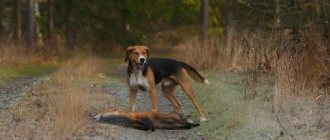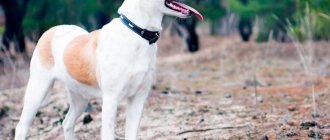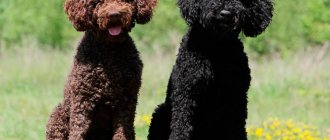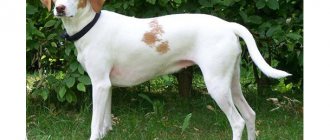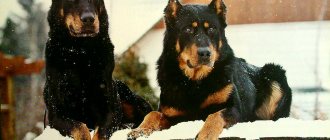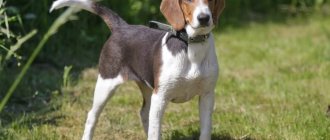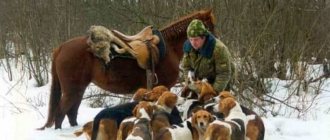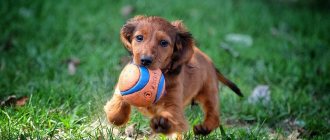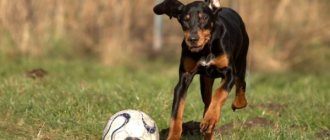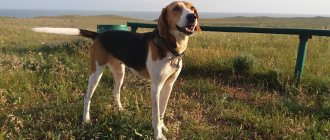Kinds
The hound classification system is very extensive. One of the parameters for separation is behavior style. Depending on it, there are 3 types of dogs for hunting:
- on horseback;
- on foot;
- for working with blood trail.
In the first case, the animals chase the victim in a group. At first they follow the horse exactly, and then together they search for and drive in the prey. Representatives of the second group hunt alone or in pairs. They not only track prey at a great distance from the owner, but are also able to pursue it for several days. After the prey is found, the dog gives a signal. The dogs of the third group follow the trail of wounded animals. During the period of pursuit, they do not make a sound. Barking is heard only after the prey is overtaken.
Another parameter for classification is appearance:
- Western hounds have rounded ears, a large muzzle and short hair.
- Oriental breeds have a flat nose, a medium-length tail and narrow, pointed ears. The muzzle and paws are covered with short hair. A distinctive feature is the absence of dewclaws.
- Animals of the brutish type are slow. However, they are quite hardy. They are characterized by a rounded skull and similar ears.
To evaluate the abilities of dogs of one or another group, experienced dog handlers conduct test competitions twice a year (spring, autumn).
Features of hunting with a Russian piebald hound
Initially, the breed was bred to be vicious towards animals, capable of participating in a long drive of not only small hares and foxes, but also wolves. Russian landowners kept various animals on their lands, and they needed a universal dog.
IMPORTANT: dogs' driving talents are inherited; before purchasing, make sure that the puppy's parents are not far from hunting, if this quality is very valuable to you.
You can accustom a Russian Pinto puppy to hunting quite early. As soon as the puppy is trained in simple commands and vaccinated with all the necessary vaccines, you can go into the forest for short walks so that the puppy tries to pick up the scent. But remember, the viscosity of the breed is very strong and do not let your pet go for a walk without a leash; if he gets carried away, he can rush off into the distance, and you will not catch him. Adult dogs are also “deaf” in the process, especially if they have a high level of hunting instinct. That’s why a breed was bred with a bright spotted color and the ability to bark during the corral process, so that the owner could keep an eye on it and not lose sight of it.
Seasoned hunters note another feature of this breed - when detecting the tracks of different animals, the barking has a different timbre and tonality, which is an interesting and practical feature of a dog for hunting.
Distinctive features
Hound dog breeds, just like greyhounds and pointers, belong to the hunting group. Their main task is to drive the wild beast under the owner’s weapon. They can spend from two hours to several days in pursuit. These dogs are known for their endurance, keen sense of smell, high speed of movement and ringing bark.
Hunting hounds also have external differences from other breeds:
- ears hang freely, tips pointing down;
- the bridge of the nose is straight;
- black lobes;
- lips fit tightly to the jaw;
- large skull;
- the back is straight;
- large breasts;
- muscular paws.
Dogs of these breeds are also distinguished by short, straight hair. Most often they have wolf, merle, red-yellow, piebald or black-backed colors.
What is the difference between breeds
The main difference between the breeds is size. According to this parameter, there are 3 types of hound dogs: small, medium and large. The former are distinguished by their small stature, which does not prevent them from performing their duties well. The latter are also characterized by compactness. They are energetic, fearless and suitable for apartment living.
Large individuals are distinguished not only by their large size, but also by special care requirements. A regular walk is not enough for such dogs. They need special physical activity. In addition, they often do not tolerate being around other animals.
The best hound breeds
The rating is based on the dogs' quality characteristics, their ability to find and pursue prey, and to interact with people and other animals.
Bloodhound
This breed has a second name - St. Hubert's dog. The first mentions of it date back to the 10th century AD. e. The breeding of the individual was carried out by the clergy. The royal nobility used the animals to hunt big game or for prospecting work.
Bloodhounds have an expressive appearance. They have an elongated body, a large head with folds of skin and long ears. A characteristic feature of such dogs is a bored look. In height they reach 62-68 cm. Weight does not exceed 54 kg. The coat is short with a red tint.
Bloodhounds have a gentle, calm character, are slow and often stubborn. They have a good sense of smell, allowing them to detect prey even after a five-day trail.
Russian hound
The first mention of this breed dates back to the 11th century AD. e. At the same time, the standard was adopted after 7 centuries. These dogs are suitable for hunting hares, foxes, wolves and wild boars. Most often they are used in a group. These individuals have the ability to follow prey in blood trails.
Russian hounds have a slow movement speed. However, they hunt in any weather.
These individuals reach 68 cm in height and weigh 30 kg. In appearance they are somewhat reminiscent of a wolf. The body is strong and muscular. The head is slightly elongated. The ears are folded in the shape of “envelopes”. The coat is short with a thick undercoat. The color is saddleback, crimson or with a gray tint. There may be white markings on the paws and chest.
By nature, dogs of this breed are kind and non-aggressive. However, they also love to be leaders. Find contact with other relatives. But other animals are often not accepted.
Poitevin Hound
It was bred in the 18th century to hunt wolves and roe deer. A distinctive feature is a high level of endurance. The dog is able to follow the scent for 20 hours without a rest break. She easily navigates through blood and runs quickly.
The height and weight of representatives of this breed reaches 72 cm and 33 kg. These individuals have long legs, ears, an athletic body and an elongated head. The short coat has a black, white or red tint.
The character of the Poitevins (second name) is fearless. At the same time, they are balanced, kind and friendly. It is not at all difficult for them to find a common language with both other animals and people.
Another feature they have is their loud, ringing “voice.”
Large Anglo-French Hound
This is one of the rarest breeds. Appeared in the provinces of France. Depending on appearance, there are 3 types:
- white-black, orange;
- tricolor.
The dogs have a friendly character. They are loyal to their owner and are easy to train. They do an excellent job both individually and in a group.
Anglo-French hounds are used when hunting large animals. Their endurance allows them to pursue prey for several hours. These individuals are excellent at following blood trails.
Great Blue Gascony Hound
Quite a rare breed that is not widespread. Appeared during the Middle Ages in France. Today this dog is considered one of the most beautiful among hounds. She has a proportional body, uniform coat with a blue tint and expressive eyes.
Animals of this breed have good eyesight and sense of smell. They easily adapt to any, even the most unfavorable, weather conditions, and are also able to follow the trail for quite a long time. Suitable for hunting small and large prey.
This is interesting: Types of greyhound dogs and their characteristics
Blue Gascony hounds have a complex character, a sharp mind and good ingenuity. They are very stubborn. Puppies need to be trained from the first months of life, otherwise they will later become uncontrollable and disobedient.
Austrian Smooth-haired Hound
According to historical data, this breed gained popularity at the end of the 15th century AD. e. Then the animals were used when hunting hares, foxes, wild boars, and birds. These dogs have not spread outside Austria.
The main feature of the Austrian hounds is their peaceful nature. They are loyal, reserved and smart. Suitable for keeping in an apartment.
Ariège Hound
As the name suggests, the breed was developed in the area of Ariège, located in the southern part of France. Its distinguishing characteristic is considered to be endurance. The dog can chase the victim for several hours in a row. Most often it is used to catch birds and hares. The recommended option for hunting with ariegeois (second name) is the rut of the animal in fields, forests and rocky areas.
Representatives of this breed are agile and playful, quickly understand people and easily learn commands.
Norwegian hound
The breed was bred at the beginning of the 19th century AD. e. in Norway. The main purpose is to hunt hares. The dog must detect the victim, track it, bring it out to shoot and then bring it to the owner. Norwegian hounds (dunkers) cope with this task perfectly. They stubbornly pursue prey in any weather, be it hot or severe frost.
This is interesting: Features of hunting with an Estonian hound
Externally, dunkers look quite attractive. Weighing from 16 to 25 kg, they reach a height of 55 cm. The body is elongated, the legs are long and muscular. Ears hang down. They are long and rounded. The short coat has a marbled color.
Norwegian hounds are known for their friendliness, loyalty and kindness. There is no aggression in them at all. They are active and mobile.
Spanish hound
Quite a rare breed with a lot of interesting features. It was bred exclusively for hunting and search work, which greatly affected the character of the dog. She easily comes into contact with people, but at the same time is completely indifferent to affection and tenderness.
The second name for the Spanish hound is Sabueso Espanyol. The expression literally translates as “bloodhound”. It characterizes animals as good detectives. That is why they are often used in the process of catching criminals or searching for narcotic substances.
Italian hound
One of the oldest breeds in Europe. The blood of its representatives was often used for breeding other varieties of dogs. Another name for it is segujio.
Italian hounds navigate any terrain. They easily cope with assigned tasks regardless of weather conditions. Suitable for hunting both large and small animals.
Distinctive character traits are gambling, loyalty, friendliness and sociability.
English Foxhound breed
Foxhound is an English hound. This is one of the most popular breeds. This dog has the blood of ancient hounds, terriers and greyhounds. Males have a strong build and thick, high paws. They began to be bred in England more than 200 years ago. The Foxhound is considered a national breed and is suitable for bird hunting.
The British bred not only foxhounds, but also larger types of dogs, their breed was called deer hounds. Today this breed has not survived. The Foxhound helped to hunt not only birds, but also foxes: the name of the breed literally translates as “Fox Race”. Males and females can easily withstand racing; they are hardy, agile and very fast. A dog can run 20 km without stopping.
Unlike other hounds, her senses are slightly weakened. Today, hunting with foxhounds is of sporting interest. X owners love to set their pets off on the wrong trail, but the agile foxhounds still run forward. This breed was often exported to America and European countries. In Russia, on their basis, the Russian piebald hound was created. The Americans created their own hound for hunting raccoons.
The Foxhound is a strong dog that can grow up to 60 cm. An adult has a wide forehead, a pronounced occipital protuberance, and a wide nose. The ears droop and lie close to the cheekbones. The Foxhound has long, unobtrusive withers, a straight back, and a developed chest. The paws are relatively small. White individuals with brown-orange and blackish spots are often found.
Sources:
- https://lapkins.ru/dog/gonchie-porodi/
- https://kotsobaka.com/sobaki/porody-s/gonchie.html
- https://tvoidrug.com/breed/svojstva/ohotnichi.html
- https://kot-pes.com/gonchaya-sobaka-porody-dlya-oxoty/
- https://sobaka.wiki/interesnoe/gonchie-sobaki-luchshie-porody/
- https://sobaka.guru/porody/vidy-gonchih/
- https://4lapki.com/2017/01/kakie-po-harakteru-gonchie-sobaki-podrobnoe-opisanie-porodyi
Education and training
The choice of parenting methods largely depends on the preferences of the owner. However, do not forget about the puppy’s character. You need to raise a dog from the first months of life, until it is easy to train. The most important requirements are learned during feeding and during walks.
- Obedience. Individuals need to be vaccinated starting from the age of two months. The idea is to shoo the dog away from the food bowl when he tries to go there. It is recommended to call the puppy by its nickname. After 2-3 minutes, still provide the opportunity to get to the food. You need to raise this way for up to 5 months.
- Wearing a collar. Teaching your dog to wear it is not that difficult. You need to put the device on so that it does not come off. At first, the puppy will try to remove the uncomfortable object, but then he will get used to it. After about 3 days, you need to call him to you and, taking him by the collar, lightly pull him forward. If the baby resists, give him something tasty and try again.
- Walking in a bow or in pairs. Here you will need a pair of collars and a belt up to 30 cm long. After the collars are put on, you need to move away from the puppies and call them to follow you. One of the pets may be stubborn. However, after both dogs will go forward.
Proper training of hounds involves the use of a horn. It is better to start learning while walking. First, you need to give the command “stand” and hold the puppy for 1-2 minutes, then give a signal and release him. After a set period of time, for example, a quarter of an hour, the signal sounds again. After this, you need to call the puppy to you.
A six-month-old dog can be taken for walks in the forest. There he will learn how to properly pursue prey.
Content
- 1 Contents of the series 1.1 Hounds - 1 1.1.1 Race for the leader
- 1.1.2 Women's share
- 1.1.3 Four Aces Poker
- 1.2.1 Until first blood
- 1.3.1 Brotherhood of Nations
- 1.4.1 Personal contact
- 1.5.1 Trap
- 1.6.1 Chkalov's last flight

